This post was written by Kevin Hoskins ’18
The members of The Sustainable Innovation MBA program at UVM were recently treated to a workshop on pitching by Cairn Cross. Cross is the co-founder and managing director of FreshTracks Capital, a venture capital firm based in Vermont that invests in early stage entrepreneurial companies. (He is part of The Sustainable Innovation MBA program’s Changemaker Network, as well as teaching the program’s class on venture capital.)
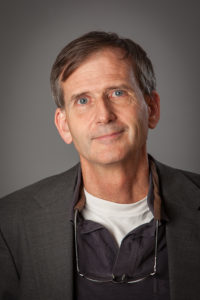 What is pitching? It is the art and skill of describing one’s project, entrepreneurial venture, or oneself in the minimal amount of words that communicates your message to the listener. For startups and entrepreneurs, it is a skill that can be developed and honed over time with practice and feedback.
What is pitching? It is the art and skill of describing one’s project, entrepreneurial venture, or oneself in the minimal amount of words that communicates your message to the listener. For startups and entrepreneurs, it is a skill that can be developed and honed over time with practice and feedback.
Cross began the workshop by outlining a number of different pitching styles. The first, is the one sentence pitch, as illustrated further by Adeo Rossi. It answers the question: “If you had to describe your company or mission in one sentence, what would it sound like?” For entrepreneurs, that response could look like this:
My (company) is developing (a well-defined offering) to help (the audience you’re targeting) (solve this problem) with (your secret sauce.)
The second style is the mantra. A mantra is a sacred verbal formula repeated in prayer, meditation or incantation such as an invocation of a god, a magic spell or a syllable or portion of scripture containing mystical potentialities. Entrepreneurs and start-ups can use mantras to explain their mission in only a few crucial words. Guy Kawasaki, in his video Don’t Write a Mission Statement, Write a Mantra, gives a few helpful examples:
- Starbucks: rewarding everyday moments
- eBay: democratize commerce
- Disney: fun family entertainment
The class was then asked to come up with mantras for The Sustainable Innovation MBA program. It’s important to remember that mantras should be short and sweet, but also outwardly focused. Your mantra should focus on the benefits that you provide to the customer.
Thirdly, Cross discussed the Art of the Pitch for entrepreneurs. The idea behind this is that entrepreneurs should always be prepared with a pitch handy for potential investors, co-founders, or partners. The pitch outline Cross illustrated and the questions you should answer in your pitch is as follows:
- Title (name, organization, contact information)
- The “Ask” (I am here today to ask you…)
- The Problem (what is customer pain you will alleviate?)
- Your Solution (why are we better?)
- Your Management Team (why are you the one(s)?)
- Your Business Model (how will you make money?)
- Any Underlying “Magic” (what is your secret sauce?)
- How Will You Reach the Customer? (sales/marketing)
- Repeat the “Ask”
Cross noted that pitches should be as concise and succinct as possible. Remember that you can only speak at most 150 words a minute comfortably. It’s also helpful, Cross noted, to think of someone on your shoulder whispering “so what?” to better focus on the value your offer needs to create for others.
Lastly, Cross touched upon the idea of the personal pitch. Have a way to describe who you are what you do clearly and succinctly in a way that resonates with people. As a way to frame your personal pitch, think of these questions:
- What’s your motivation?
- What do you do well?
- Why you?
Answering those questions is key to communicating your personal secret sauce.
Do you have a business idea that you’ve been working on? Can you say it in 140 characters or less? Tweet your business idea to @vtcairncross. Just remember to keep it concise!
Editor’s Note: What should we call a business pitch delivered by tweet? A “twitch”? Or a “peetch”?


 A large portion of the conference’s attendees were people serving on local energy committees — people looking for ways to identify action plans for their towns and communities to implement specific environmentally minded policies and improvements.
A large portion of the conference’s attendees were people serving on local energy committees — people looking for ways to identify action plans for their towns and communities to implement specific environmentally minded policies and improvements.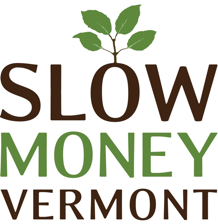 On December 6, Slow Money Vermont hosted its 3rd annual Entrepreneurial Showcase at the Main Street Landing Performing Art Center in Burlington. Together with the Moulton Law Group, Milk Money, Flexible Capital Fund, City Market, and other sponsors, the program brought together entrepreneurs and investors with a shared vision for local, sustainable food and farms. Slow Money Vermont “catalyzes new investment opportunities in the people, businesses and community that contribute to a sustainable food economy.” A project of the Farm to Plate Network, Slow Money Vermont is part of a national movement headquartered in Boulder, Colorado.
On December 6, Slow Money Vermont hosted its 3rd annual Entrepreneurial Showcase at the Main Street Landing Performing Art Center in Burlington. Together with the Moulton Law Group, Milk Money, Flexible Capital Fund, City Market, and other sponsors, the program brought together entrepreneurs and investors with a shared vision for local, sustainable food and farms. Slow Money Vermont “catalyzes new investment opportunities in the people, businesses and community that contribute to a sustainable food economy.” A project of the Farm to Plate Network, Slow Money Vermont is part of a national movement headquartered in Boulder, Colorado. One of the key points many of the speakers made throughout the weekend was on mindset. Changing mindsets about the current globalized economy is the first step towards changing the system as a whole. One of the ways speakers encouraged a change in mindset was to recognize that in our current system we commodify all aspects of our life. Indigenous Leader
One of the key points many of the speakers made throughout the weekend was on mindset. Changing mindsets about the current globalized economy is the first step towards changing the system as a whole. One of the ways speakers encouraged a change in mindset was to recognize that in our current system we commodify all aspects of our life. Indigenous Leader 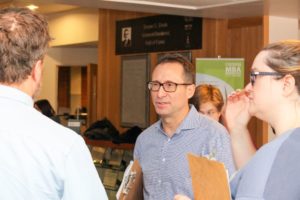 On the last day of November, the students of The Sustainable Innovation MBA hosted their annual Business Model Trade Show in the bustling lobby of Kalkin Hall. Visitors toured booths, sampled products and learned about the creative enterprises students have been working on throughout Module 2. For the students, it was a great opportunity to hone their elevator pitch and get feedback for their business ideas from noted visitors like venture capitalist and UVM alum
On the last day of November, the students of The Sustainable Innovation MBA hosted their annual Business Model Trade Show in the bustling lobby of Kalkin Hall. Visitors toured booths, sampled products and learned about the creative enterprises students have been working on throughout Module 2. For the students, it was a great opportunity to hone their elevator pitch and get feedback for their business ideas from noted visitors like venture capitalist and UVM alum 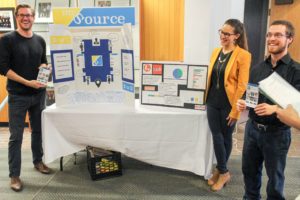 Many of the businesses focus on creating consumer goods that fill an unmet or underserved need in the marketplace. For instance, B3 is a consumer health company that offers simple, effective and environmentally friendly shampoo products made entirely from water, baking soda, and essential oils. Visitors to the trade show learned that the average shampoo contains more than 30 ingredients, many of which are known to cause adverse health and environmental effects. Another team of students with science and engineering backgrounds created Conscious Coffee Pods: small on the go servings of coffee in an algae-based pod that are shelf-stable, easily dissolved in water, and produce no packaging waste. Yet a third team created Flip Balm, an on the go algae-based sunscreen that attaches to a wristband made of recycled ocean plastic.
Many of the businesses focus on creating consumer goods that fill an unmet or underserved need in the marketplace. For instance, B3 is a consumer health company that offers simple, effective and environmentally friendly shampoo products made entirely from water, baking soda, and essential oils. Visitors to the trade show learned that the average shampoo contains more than 30 ingredients, many of which are known to cause adverse health and environmental effects. Another team of students with science and engineering backgrounds created Conscious Coffee Pods: small on the go servings of coffee in an algae-based pod that are shelf-stable, easily dissolved in water, and produce no packaging waste. Yet a third team created Flip Balm, an on the go algae-based sunscreen that attaches to a wristband made of recycled ocean plastic. What has been your favorite part/element of the program thus far?
What has been your favorite part/element of the program thus far?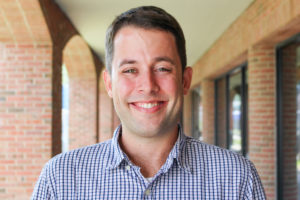 Finding time to both reflect on and celebrate successful team projects, or debrief on things that could have worked better, has often taken a backseat to other pressing needs.
Finding time to both reflect on and celebrate successful team projects, or debrief on things that could have worked better, has often taken a backseat to other pressing needs. This was the weekly struggle this semester as I attempted to keep up with classwork, teamwork, and a community supported agriculture (CSA) share. My share, paid for at the beginning of the season to provide farmers a more stable income and seed start up costs, got delivered weekly to a campus drop off spot. (For more information about CSAs please see
This was the weekly struggle this semester as I attempted to keep up with classwork, teamwork, and a community supported agriculture (CSA) share. My share, paid for at the beginning of the season to provide farmers a more stable income and seed start up costs, got delivered weekly to a campus drop off spot. (For more information about CSAs please see  With some very experienced hikers in this year’s cohort we’ve had a handful of successful hikes including Mt. Mansfield and Starks Nest. Other classmates have hit the road and enjoyed a charity bike ride for Old Spokes Home and one of our very own classmates, Becky Miller, led a local yoga class that many attended. Being a graduate student at UVM means you get to enjoy a beautiful landscape and a vibrant community. Beyond the university offerings, Burlington has a variety of outdoor offerings for everyone.
With some very experienced hikers in this year’s cohort we’ve had a handful of successful hikes including Mt. Mansfield and Starks Nest. Other classmates have hit the road and enjoyed a charity bike ride for Old Spokes Home and one of our very own classmates, Becky Miller, led a local yoga class that many attended. Being a graduate student at UVM means you get to enjoy a beautiful landscape and a vibrant community. Beyond the university offerings, Burlington has a variety of outdoor offerings for everyone. During the semester, almost half of our class participated in intramural sports offered by campus recreation. Campus Recreation offers a variety of options from multi-week team sports to one-night clinics, all free, or practically free. As a class we competed in broomball, kickball and volleyball. Games are weekly and the games and the season-ending tournament usually last from 4 to 6 weeks. While we didn’t take home any campus-wide championships this semester, we won some games, worked off some steam and got a little exercise, which is always nice after sitting in class for most of the day. There were also awesome events like a “Learn How to Curl” event in which a local curling club taught us the basics of curling. Due to our busy schedules, we won’t be joining the 2018 Winter Olympics, but we might shoot for the 2022 Winter games.
During the semester, almost half of our class participated in intramural sports offered by campus recreation. Campus Recreation offers a variety of options from multi-week team sports to one-night clinics, all free, or practically free. As a class we competed in broomball, kickball and volleyball. Games are weekly and the games and the season-ending tournament usually last from 4 to 6 weeks. While we didn’t take home any campus-wide championships this semester, we won some games, worked off some steam and got a little exercise, which is always nice after sitting in class for most of the day. There were also awesome events like a “Learn How to Curl” event in which a local curling club taught us the basics of curling. Due to our busy schedules, we won’t be joining the 2018 Winter Olympics, but we might shoot for the 2022 Winter games.